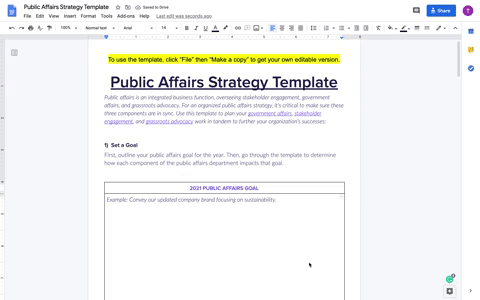1) Set a Goal
First, determine the elements of public policy that would be beneficial to change. Once you have the policy changes in mind outline your public affairs goal for the year. Then, go through the template to determine how each component of the public affairs department impacts that goal.
One example of a policy goal could be to secure a certain number of cosponsors for a key bill. Having this concrete goal helps advocates see the value in their work and drives action. See how the International Health, Racquet & Sportsclub Association (IHRSA) uses advocacy dashboards to incentivize advocates to send emails to members of Congress and drive new bill cosponsors.
As your organization works to pursue that goal, stay aware of current government policy and priorities as it relates to your objectives — as the policy landscape changes, you may need to adjust your goal. This can be done with Quorum’s wide range of solutions. See how Kivvit uses Quorum insights to provide a next-generation public affairs strategy.
2) Map Stakeholders
Mapping stakeholders is a critical step early because it will help in your eventual measurement of your public affairs success. Consider mapping stakeholders with an interest-influence matrix. Then, track your engagement with each stakeholder, and reevaluate where each stakeholder belongs on the matrix at the end of the year, reporting on how many stakeholders you were able to build into more interested or more influential stakeholders. (Don’t think an interest-influence matrix is the best fit for mapping your organization’s stakeholders? Consider these other options.)
3) Communicate Your Message to Stakeholders
A key way to get your message across to stakeholders is through email, but it needs to be done thoughtfully and in a proper cadence so that your stakeholders will open and read what you’re sending them. Use a team-wide calendar to make sure everyone is on the same page with what content you are sharing with stakeholders.
4) Plan Your Engagement with Stakeholders
While email is valuable, it’s also critical to have face-to-face engagement between your organization and it’s stakeholders. This can take many different forms—site visits, roundtable discussions, one-on-one meetings, or even holiday parties. Use this calendar to plan your events, who the target audience is, and what your objective is for each event.
5) Integrate Grassroots Advocacy
If your public affairs goal involves legislation at the federal or state level, consider calling on your non-government stakeholders to reach out to their legislators on behalf of the issue your organization cares about. With a well-organized grassroots program, organizations can communicate through constituents from a legislator’s district to get their attention, utilize personal relationships, and share stories with legislators. Use a checklist to make sure your team isn’t missing any key advocacy activities.
6) Report on Your Success
Based on the mapping system you implemented in step 2, go back and map your stakeholders again and see what movement was made between quadrants. Then, build a report of how many times you engaged with each stakeholder, broken down by type of engagement to see if there are patterns in which kinds of engagement increased the influence or interest of a given stakeholder.
Best Practice:
Now that you’ve seen some of the key strategies your team should outline for a successful public affairs strategy, consider the tools that help synchronize each of these strategies in one place. Public affairs professionals use integrated software platforms like Quorum to help their teams work smarter and move faster.



